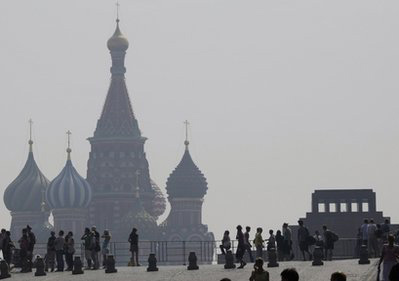|
 In this July 29, 2010 file photo, Moscow's St. Bazil's Cathedral, background, is seen through a smog covering Moscow during a heat wave. The mausoleum of Vladimir Lenin is at right. The excessive amount of extreme weather that dominated 2010 is a classic sign of man-made global warming that climate scientists have long warned about. They calculate that the killer Russian heat wave, setting a national record of 111F (nearly 44 C), would happen once every 100,000 years without global warming. |
|
This was the year the Earth struck back. Earthquakes, heat waves, floods, volcanoes, super typhoons, blizzards, landslides and droughts killed at least a quarter million people in 2010 — the deadliest year in more than a generation. More people were killed worldwide by natural disasters this year than have been killed in terrorism attacks in the past 40 years combined. "It just seemed like it was back-to-back and it came in waves," said Craig Fugate, who heads the US Federal Emergency Management Agency. It handled a record number of disasters in 2010. "The term ‘100-year event’ really lost its meaning this year." And we have ourselves to blame most of the time, scientists and disaster experts say. Even though many catastrophes have the ring of random chance, the hand of man made this a particularly deadly, costly, extreme and weird year for everything from wild weather to earthquakes. Poor construction and development practices conspire to make earthquakes more deadly than they need be. More people live in poverty in vulnerable buildings in crowded cities. That means that when the ground shakes, the river breaches, or the tropical cyclone hits, more people die. The January earthquake that killed well more than 220,000 people in Haiti is a perfect example. Port-au-Prince has nearly three times as many people — many of them living in poverty — and more poorly built shanties than it did 25 years ago. So had the same quake hit in 1985 instead of 2010, total deaths would have probably been in the 80,000 range, said Richard Olson, director of disaster risk reduction at Florida International University. Climate scientists say Earth's climate also is changing thanks to man-made global warming, bringing extreme weather, such as heat waves and flooding. The excessive amount of extreme weather that dominated 2010 is a classic sign of man-made global warming that climate scientists have long warned about. They calculate that the killer Russian heat wave — setting a national record of 111 degrees — would happen once every 100,000 years without global warming. Preliminary data show that 18 countries broke their records for the hottest day ever. White House science adviser John Holdren said we should get used to climate disasters or do something about global warming: "The science is clear that we can expect more and more of these kinds of damaging events unless and until society's emissions of heat-trapping gases and particles are sharply reduced." (Read by Nelly Min. Nelly Min is a journalist at the China Daily Website.) (Agencies) |
今年,地球開始反擊了。 2010年死于地震、熱浪、洪災、火山噴發、超強臺風、暴風雪、山體滑坡和干旱的人數超過了25萬人,是30多年來死亡人數最多的一年。全球死于自然災難的人數超過過去40年來死于恐怖主義襲擊的人數的總和。 美國聯邦緊急事務管理局局長克雷格?富蓋特說:“(災難)像海浪般接踵而至。” 2010年該局處理的災難數目突破了歷史記錄。 “在這種情況下,‘百年一遇’一詞也失去了意義”,尤蓋特說。 科學家和災難專家們認為大部分災難都是人類自己造成的。 盡管很多災難看起來是偶發事件,但是人類的行為使得今年的自然災害(從惡劣的天氣到毀滅性的地震)造成的后果尤其嚴重。今年是死亡人數飆升、損失慘重、天氣極端異常的一年。 低劣的建筑質量和開發行為加大了地震的殺傷力。越來越多的人擠在城市的危房里,過著貧苦的生活。這意味著,一旦地震發生、河堤決口、或者熱浪來襲,會有更多的人死亡。 一月份發生的造成22萬多人死亡的海地地震就是一個典型的例子。跟25年前相比,海地首都太子港市的人數增加了兩倍,很多人生活貧困,城市中到處都是簡陋的棚戶區。“如果同樣的地震發生在1985年,那么死亡人數應該在8萬左右”,弗羅里達國際大學減災辦公室主任理查德?奧爾森說。 氣象科學家說地球的氣候也在發生變化。人為造成的全球變暖帶來了極端的天氣,使得熱浪肆虐,洪水泛濫。 2010年過度頻繁的極端天氣是人為全球變暖的一個顯著表現。氣象科學家們一直都在警告人們注意全球變暖,他們推算說如果沒有全球變暖的話,那么今年在俄羅斯發生的破紀錄的111度(華氏)高溫天氣每10萬年才會發生一次。 之前的數據顯示,今年有18個國家的最高氣溫打破了歷史紀錄。 白宮科學顧問約翰?霍德倫認為,我們應該采取行動應對全球變暖,不然就得適應氣候災難。“道理很清楚,如果我們不能大量減少吸熱氣體和微粒的排放,那么這種極具破壞力的災難會越來越多。” 相關閱讀 (中國日報網英語點津 崔旭燕 編輯:陳丹妮) |
|
Vocabulary: a generation: 一代通常認為大約30年 back-to-back: 接連地;接二連三地 have the ring of: 聽起來,看起來 cyclone: a violent tropical storm in which strong winds move in a circle(氣旋;旋風) |
